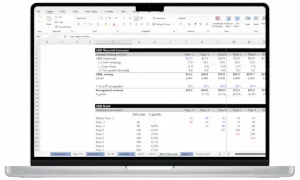You may have heard of mega funds in private equity, but who are they and what is the definition?
Mega funds are a massively important part of the private equity ecosystem, and these funds are some of the most prestigious firms to work at in the industry.
In this article, I’ll be looking at what a private equity mega fund is, the top mega funds in the industry, and what you should know about getting a job at a private equity mega fund.
What Are the Mega-Funds in Private Equity?
The first thing to say is there isn’t a strict definition of what a “mega fund” is.
In general, mega-funds are private equity funds with the largest assets under management.
There is no strict cutoff for assets in this regard, but the PE mega funds are usually enormous with several billion in assets under management. PE firms have experienced massive growth in recent years due to the explosion of assets under management.
Some refer to a private equity mega fund as having more than $10 billion in assets, but that description is a bit too general. Some mega funds on the list below have far higher amounts.
With their large amounts of capital to invest, typically mega funds do the biggest deals. That’s why mega funds exist. These deals happen the same way they do for middle-market private equity funds but on a much larger scale.
Because private equity firms make money through fees as a percentage of assets under management, the mega funds traditionally make the most money and pay the highest salaries, as a result. Because it typically doesn’t require THAT many more people to do a $1 billion LBO investment vs. a $50 million LBO, the mega funds have relatively high revenue per employee. Hence, they can afford to pay higher salaries.
List of Mega Funds
Here are the firms I consider to be the top PE mega funds. Let’s take a closer look.
Blackstone Group
Founded in 1985 by Stephen A. Schwarzman and Peter G. Peterson, the Blackstone group started with an initial $400,000 capital. Today the firm is one of the largest investment firms in the world, with hundreds of billions in assets under management. Based in New York City, this company is well-established and respected in the industry.
A few popular investments for the Blackstone group include Bumble, Hilton Worldwide, Hello Sunshine, and Ancestry.
Apollo Global Management
Established by Josh Harris, Leon Black, and Mac Rowan, the Apollo Global Management headquarters is located in New York City. The company has offices across the globe and is a highly reputable organization in the industry. In 2022, Apollo merged with Athene, making one large publicly traded company.
Some popular investments by Apollo Global Management include Barnes & Noble, Rackspace, and Shutterfly.
Carlyle Group
The Carlyle Group was founded in 1987 by Greg Rosenbaum, William E. Conway Jr, David Rubenstein, Stephen L. Norris, and Daniel A. D’Aniello. It is one of the top investment groups in the world, with billions in investments across multiple continents. It has various offices around the globe, with headquarters in Washington, DC.
Some of the top global investments made by the Carlyle Group include Supreme, Grand Foods Holdings Limited, and Golden Goose Deluxe Brand.
KKR & Co
KKR & Co was founded in 1976 by Henry Kravis and George Roberts. Today, the New York-based company is exceptionally well known for its massive investments and growth opportunities.
Some notable investments made by KKR & Co include ByteDance, Epic Games, and JB Chemicals & Pharmaceuticals Ltd.
TPG Capital
Created in 1992 by Jim Coulter and David Bonderman, TPG Capital is a San Francisco-based company. It is a leader in global asset management and widely recognized for its unique approach to alternative investment.
Some popular investments made by TPG Capital include Burger King, AirbnB, and McAfee.
Honorable mentions
As I said previously, there’s no strict definition for a private equity mega fund. Below are more funds that many in the industry would consider a mega fund:
- Apax Partners
- Warburg Pincus
- Advent International
- Silver Lake
- Bain Capital
- CVC Advisers
How Mega Funds Are Evolving
Most of the mega funds started as pure “buyout” private equity investors. This means they used high debt loads to purchase companies and earn returns in their deals.
However, in today’s market many mega funds have evolved their business model to have many different lines of business and investment strategies.
Some common business lines include:
- Venture capital
- Investment banking and capital markets
- Real estate
- Infrastructure
- Public markets/hedge funds
- Growth equity
This evolution of private equity firms means that they are essentially becoming large-scale asset management companies, who are no longer tied to the boom and bust cycle of leveraged buyouts (which are beholden to interest rates).
It has also allowed funds to raise capital and earn fees from LPs without cannibilizing their existing business.
Reasons to Consider Working at Top Mega Funds
Working at a top mega fund is highly desirable for many candidates. Here are some of the top reasons why:
- Highly prestigious: These companies made it onto our list for a reason. They are well-known and respected in the industry. Finding roles at any top firm means joining an extremely prestigious organization with incredible exit opportunities from there.
- Very strong compensation: Since these investment firms have huge assets under management (and charge large fees on top of that), it’s no surprise that they can afford to hire the best. This means they pay exceptionally well, and the compensation can be large at every level.
- Great for your resume and exit opportunities: If you’re ever in the job market after employment at one of these private equity firms, your job opportunities (or MBA application odds) increase dramatically. Having one of the firms on your resume looks brilliant, particularly if you’ve managed to stay on for a few years.

- 66 lessons
- 12+ video hours
- Excels & templates
Reasons You May Not Want to Work at Top PE Mega Funds
While mega funds offer incredible opportunities, it’s also true that there are downsides to working there. Here are a few considerations you should keep in mind before you go mega fund or bust:
- Very challenging to win an interview/offer: Getting your foot in the door at prestigious private equity firms is very tough. You need an excellent private equity resume with a lot of experience and studies to back it up. Check out my guide on how to standout and get into private equity
- Hierarchical structure: In a top mega fund, there isn’t a lot of autonomy and there is pretty strict career progression. Many analysts and associates find it challenging to thrive since there’s so much hierarchical structure.
- Very crowded: There is lots of competition for promotions. Everyone who works at these funds is A+, and they want to further their own career. That means career progression is generally competitive because is fighting against each other for promotions.
- Challenging work/life balance: Working in one of these private equity mega funds can require very long hours and high commitment. While every situation is different, you’ll likely have to give up a lot of weekends and free time to make yourself available for work. However, you are well compensated for the sacrifice.
- Difficult to outperform benchmarks: Once flagship funds reach a certain point, it’s challenging to perform how they would have as smaller private equity funds. Smaller deals with unique asset classes do very well because it’s new. However, once PE firms grow, they’re up against the top competitors with fewer niche investment opportunities.
Mega Fund Private Equity Salary
Salaries in private equity mega-funds vary greatly, and the pay depends on the role, location, and size of the investment firm.
Here are the average salaries in the US, including bonuses:
- Associate: $150k-$300k
- Senior Associates: $410k-$610k
- Vice President: $570K-$780K
If you make it past this point, you can expect to earn into the millions, but this is based on the size of the private equity mega funds you’re dealing with. You can also expect real dollars from carried interest, which is something to be aware of.
FAQs
What Is The Largest Mega Fund?
As of December 2022, Blackstone Group has over $289 billion in private equity. They have a further $326 billion in real estate, $80 billion in hedge fund solutions, and $280 billion in credit and insurance.
How Much Are Mega Fund Deals Worth?
An average mega private equity fund does deals involve equity checks over $1 billion, with individual funds ranging $10-$15 billion in size.
Which Country Is Best For Jobs At Private Equity Mega Funds?
North America would be your best bet. Most mega fund firms have headquarters in North America (usually New York City or San Francisco).


 Break Into Growth Equity
Break Into Growth Equity

